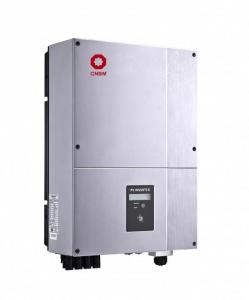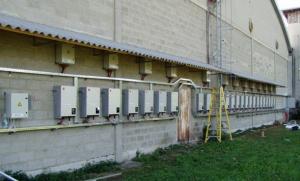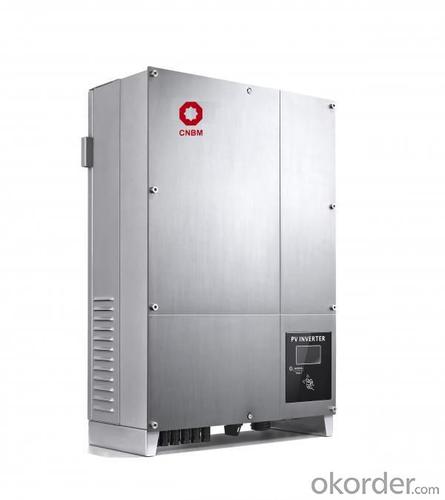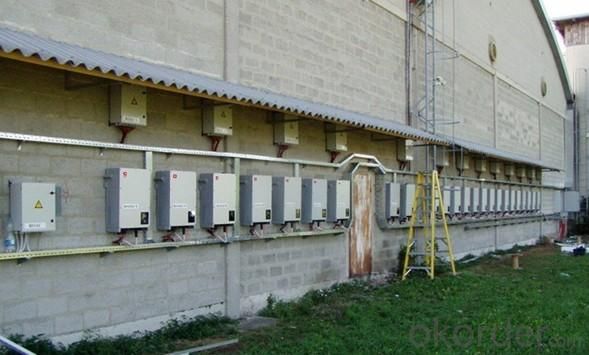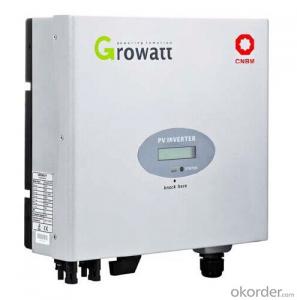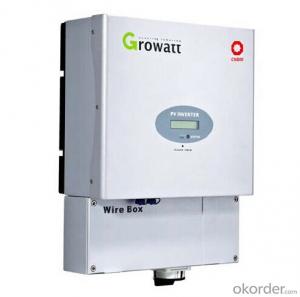Homage Solar Inverter Grid Tied 3-Phase CNBM-10000UE
- Loading Port:
- NanJing
- Payment Terms:
- TT
- Min Order Qty:
- 1 set set
- Supply Capability:
- 1000/month set/month
OKorder Service Pledge
OKorder Financial Service
You Might Also Like
Features of Grid Tied Solar Inverter 3-Phase CNBM-10000UE
CNBM International Corporation (CNBM International) is the most important trading platform of CNBM Group Corporation, a state-owned company under the direct supervision of State-owned Assets Supervision and Administration Commission of the State Council.
With a R&D team more than 100 engineers,40% of the staff, who has been deeply engaged in the photovoltaic industry for 10 years, CNBM takes the mission to increase the inverter availability and efficiency, putting continuous innovation to make CNBM inverter easier for installation and operation, and more cost-effective for solar plant construction. The full range of CNBM single phase inverters has received VDE, CE, G83/1, G59/2, ENEL2010, VDE4105, C10/C11, AS4777 etc.
Maximum efficiency of 97.8% and wide input voltage range, Internal DCswitch,MTL-String, Sound control,Bluetooth/RF technology /WiFiTransformerless,GT topology
The Grid Connected Solar Inverter we can offer is 1.5kw to 20kw.
Introduction of Grid Tied Solar Inverter 3-Phase CNBM-10000UE
Maximum efficiency of 97.8% and wide input voltage range
Integrated DC switch-disconnected
MTL-String
Sound control
Bluetooth/RF technology /Wi-Fi
Transformerless GT topology
5 years warranty (10 years as optional)
Technical data of Grid Tied Solar Inverter 3-Phase CNBM-10000UE
Model | CNBM-10000UE | CNBM-12000UE | |
Input data (DC) |
|
| |
Max. DC power | 10500W | 12500W | |
Max. DC voltage | 1000V | 1000V | |
Start voltage | 350V | 350V | |
PV voltage range | 180V-1000V | 180V-1000V | |
Max. input current | 15A | 17A | |
Number of MPP trackers /strings per MPP tracker | 2/2 | 2/2 | |
Output (AC) |
| ||
Rated AC output power | 10000W | 12000W | |
Max. AC power | 10000VA | 12000VA | |
Max. output current | 16A | 19A | |
Power factor | 1 | 1 | |
THDI | <3% | <3% | |
AC connection | Three phase | Three phase | |
Efficiency |
| ||
Max. efficiency | 98% | 98% | |
Euro weighted efficiency | 97.5% | 97.5% | |
MPPT efficiency | 99.5% | 99.5% | |
Protection devices |
| ||
Output over voltage protection-varistor | yes | yes | |
Ground fault monitoring | yes | yes | |
Grid monitoring | yes | yes | |
General Data |
| ||
Dimensions (W / H / D) in mm | 740/440/235 | 740/440/235 | |
Weight | 41KG | 41KG | |
Operating temperature range | –25°C ... +60°C | –25°C ... +60°C | |
Altitude | 2000m(6560ft) without derating | ||
Self-Consumption night | < 0.5 W | < 0.5 W | |
Topology | Transformerless | ||
Cooling concept | Natural | Natural | |
Environmental Protection Rating | IP65 | IP65 | |
Features |
| ||
DC connection | H4/MC4(opt) | H4/MC4(opt) | |
Display | LCD | LCD | |
Interfaces: RS485/RS232/Bluetooth / RF/Zigbee/Wifi | yes/yes/opt/opt/opt | ||
Warranty: 5 years / 10 years | yes /opt | ||
Certificates and approvals | CE、VDE 0126-1-1、DK5940、G83/1-1、G59/2、RD1663、EN50438、 VDE-AR-N4105、CEI-021、IEC-62109、ENEL-Guide | ||
Grid Tied Solar Inverter 3-Phase CNBM-10000UE is simple national setting of line supply monitoring, Easy country configuration, with Multi-language,display, currently available for most of the countries over the world.With technical creativity and scientific management, the factory established first class R&D and test centers, as well as management and R&D teams comprising of PhDs and masters with overseas qualification.
Figure 1 the application of Grid Tied Solar Inverter 3-Phase CNBM-10000UE
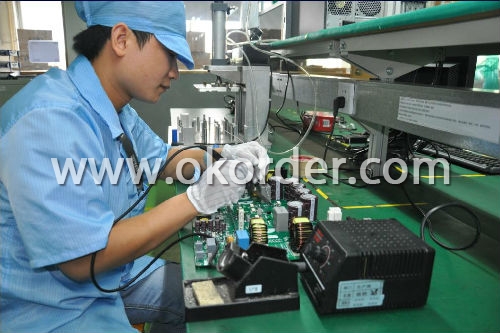
Figure 2 The Stock of Grid Tied Solar Inverter 3-Phase CNBM-10000UE
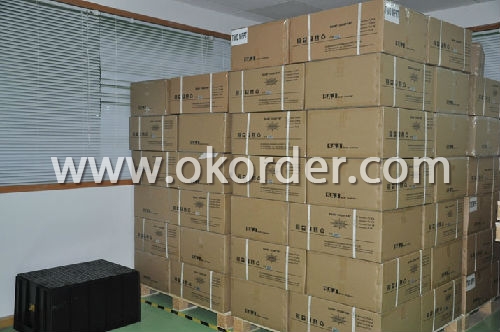
- Q: How does a solar inverter handle variations in grid frequency?
- A solar inverter handles variations in grid frequency by constantly monitoring the frequency of the grid and adjusting its own output accordingly. It does this through a process called frequency synchronization, where it synchronizes its output frequency with the grid frequency. This allows the solar inverter to seamlessly adapt to any changes in grid frequency, ensuring a stable and reliable power supply to the connected solar panels or the grid.
- Q: Can a solar inverter be integrated with a smart home system?
- Yes, a solar inverter can be integrated with a smart home system. Many modern solar inverters have built-in communication capabilities, such as Wi-Fi or Ethernet, which allow them to connect to a smart home system. This integration enables homeowners to monitor and control their solar power production and energy consumption conveniently through a centralized smart home platform. They can track energy production, set energy usage preferences, and even automate certain functions based on available solar power.
- Q: What are the advantages of using a solar inverter?
- The advantages of using a solar inverter include the conversion of DC power from solar panels into AC power suitable for use in homes and businesses, the ability to sell excess electricity back to the grid, reduced reliance on fossil fuels, lower energy bills, and environmental benefits such as reduced carbon emissions.
- Q: Do I need a special inverter for a battery storage system?
- Yes, a special inverter is needed for a battery storage system. Unlike a regular inverter that converts DC power from solar panels into AC power for immediate use, a battery storage system requires an inverter that can not only convert DC power to AC power but also manage the charging and discharging of the batteries efficiently. This special inverter is designed to work seamlessly with the battery storage system, ensuring optimal performance and maximizing the utilization of stored energy.
- Q: What is the role of frequency support in a solar inverter?
- The role of frequency support in a solar inverter is to maintain a stable and consistent frequency of the electricity being generated by the solar panels. This is important because the frequency of the electricity needs to match the frequency of the grid in order to ensure smooth and reliable power transmission. The solar inverter constantly monitors the frequency of the grid and adjusts the output of the solar panels to match it, helping to stabilize the overall grid frequency and maintain the integrity of the electrical system.
- Q: Can a solar inverter be used with a time-of-use electricity tariff?
- Yes, a solar inverter can be used with a time-of-use electricity tariff. A solar inverter is responsible for converting the direct current (DC) produced by solar panels into alternating current (AC) that can be used to power household appliances. It is compatible with different types of electricity tariffs, including time-of-use tariffs, which charge different rates for electricity usage based on specific times of the day. By integrating a solar inverter with a time-of-use tariff, homeowners can optimize their energy consumption and potentially save on their electricity bills by utilizing solar power during off-peak hours when rates are lower.
- Q: What is the role of MPPT (Maximum Power Point Tracking) in a solar inverter?
- The role of MPPT (Maximum Power Point Tracking) in a solar inverter is to optimize the efficiency and output of the solar panel system. MPPT technology enables the inverter to constantly track and adjust the operating point of the panels, ensuring that they are operating at their maximum power point, where the highest power output is achieved. This allows the system to capture the maximum amount of energy from the sun, maximizing the overall efficiency and performance of the solar inverter.
- Q: What is the power factor of a solar inverter?
- The power factor of a solar inverter is a measure of how effectively it converts the DC power generated by solar panels into AC power that can be used by electrical devices. A high power factor indicates efficient conversion, while a low power factor signifies energy losses.
- Q: How do you choose the right input voltage range for a solar inverter?
- To choose the right input voltage range for a solar inverter, you need to consider the specifications of your solar panels and the requirements of the inverter. You should check the voltage output range of your solar panels and ensure that the inverter's input voltage range is compatible with it. Additionally, consider any potential variations in solar panel output due to factors like temperature and shading. It is advisable to choose an inverter with a slightly higher input voltage range to accommodate any fluctuations and maximize the efficiency of the system.
- Q: Are there any voltage or frequency regulations for solar inverters?
- Solar inverters are subject to voltage and frequency regulations, which differ depending on the country and are typically established by regulatory bodies or standardization organizations. To ensure the safe and reliable operation of the electrical grid, solar inverters in most countries must adhere to specific voltage and frequency limits. Voltage regulations dictate the permissible range of output voltage that a solar inverter can supply to the grid. This guarantees that the voltage remains within acceptable boundaries, preventing damage to electrical equipment or disturbances in grid stability caused by overvoltage or undervoltage conditions. The specific voltage limits are influenced by factors such as the type of grid system (e.g., single-phase or three-phase) and the voltage levels employed in the country. In contrast, frequency regulations establish the acceptable range of output frequency that a solar inverter can provide to the grid. The grid frequency is typically set at a specific value (e.g., 50 Hz or 60 Hz), and solar inverters must synchronize their output frequency with the grid to ensure compatibility. Deviations from the specified frequency can result in equipment malfunctions or grid instability. Compliance with voltage and frequency regulations is essential for solar inverters to facilitate the effective integration of renewable energy sources into the electrical grid. In numerous countries, solar inverters must meet specific technical standards or certifications to demonstrate their adherence to these regulations. These standards typically encompass various aspects of inverter performance, including voltage and frequency control, power quality, and interaction with the grid.
Send your message to us
Homage Solar Inverter Grid Tied 3-Phase CNBM-10000UE
- Loading Port:
- NanJing
- Payment Terms:
- TT
- Min Order Qty:
- 1 set set
- Supply Capability:
- 1000/month set/month
OKorder Service Pledge
OKorder Financial Service
Similar products
Hot products
Hot Searches
Related keywords

